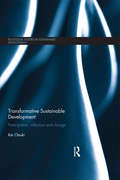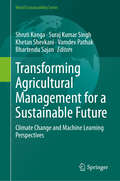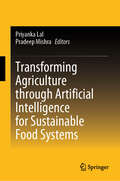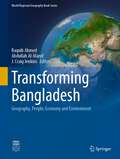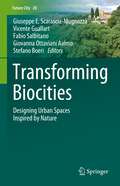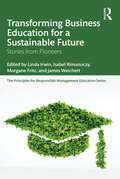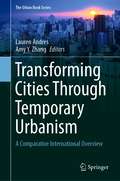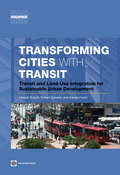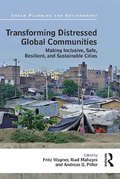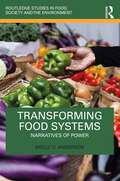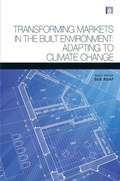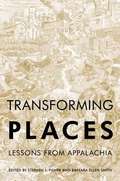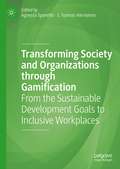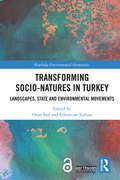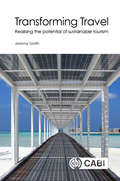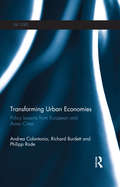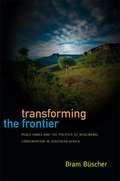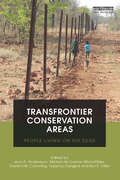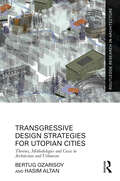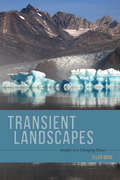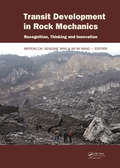- Table View
- List View
Transformative Sustainable Development: Participation, reflection and change (Routledge Studies in Sustainable Development)
by Kei OtsukiRecent debates about sustainable development have shifted their focus from fixing environmental problems in a technocratic and economic way to more fundamental changes in social-political processes and relations. In this context, participation is a genuinely transformative approach to sustainable development, yet the process by which participation leads to transformation is not sufficiently understood. This book considers how the act of participating in sustainable development projects can bring about social transformation that is considered to be fair and just by the participants and non-participants in a broader societal context. Drawing on ideas from social theory and applied anthropology, the book proposes a reflexivity-based framework to analyse participation as a type of social action underpinned by primary experience. Development projects have a transformative effect when participants are given the opportunity to reflect on their experience, share the reflection with others, and open new space for collective deliberation and change. The book applies this framework to assess community-based participatory projects in the Amazon, African slums and rural settlements, and disaster stricken areas in Japan. It also outlines potential institutions of governance to institutionalize the change by referring to current food governance, drawing out lessons with international relevance. This book will be of interest to students of sustainable development, environmental policy and development studies, as well as practitioners and policy-makers in these fields.
Transforming Agricultural Management for a Sustainable Future: Climate Change and Machine Learning Perspectives (World Sustainability Series)
by Shruti Kanga Suraj Kumar Singh Khetan Shevkani Vamdev Pathak Bhartendu Sajan"Transforming Agricultural Management for a Sustainable Future: Climate Change and Machine Learning Perspectives" is an essential read for anyone interested in the future of agriculture and the role that technology can play in mitigating the impact of climate change. The book delves into the challenges facing agriculture today, such as climate change, soil degradation, and water scarcity. It then explores how machine learning can be used to overcome these challenges and promote sustainable agricultural practices. One of the key takeaways from the book is the importance of data-driven decision-making in agriculture. With the help of machine learning algorithms, farmers can analyze vast amounts of data, such as weather patterns, soil quality, and crop yields, to make informed decisions about planting, irrigation, and fertilizer use. By using this data, farmers can optimize their yields while minimizing their impact on the environment. Another important aspect of the book is its focus on climate change. Agriculture is one of the largest contributors to greenhouse gas emissions, and farmers are already feeling the impact of climate change through droughts, floods, and other extreme weather events. The book provides a comprehensive overview of the ways in which machine learning can be used to reduce the impact of agriculture on the environment, such as by optimizing irrigation and reducing fertilizer use. The book also explores the role of technology in promoting sustainable agriculture practices. For example, precision agriculture techniques, such as GPS-guided tractors and drones, can help farmers reduce waste and improve crop yields. The book provides examples of how these techniques are already being used in practice, and how they can be further developed to promote sustainability. Overall, "Transforming Agricultural Management for a Sustainable Future: Climate Change and Machine Learning Perspectives" is an insightful and informative read for anyone interested in the future of agriculture. The book provides a comprehensive overview of the challenges facing agriculture today and the ways in which technology can be used to overcome these challenges and promote sustainable practices. It is a must-read for farmers, policymakers, and anyone interested in the future of our planet.
Transforming Agriculture through Artificial Intelligence for Sustainable Food Systems
by Pradeep Mishra Priyanka LalThis book aims to explore the groundbreaking intersection of artificial intelligence (AI) and agriculture, focusing on how innovative technologies can be harnessed to create sustainable and resilient food systems. As global challenges such as climate change, population growth, and resource scarcity intensify, this book seeks to provide a comprehensive guide to leveraging AI for optimizing agricultural practices, enhancing productivity, and promoting environmental stewardship. The final chapter summarizes key findings, highlighting the overarching themes, and providing insights into the future of AI in agriculture. Emphasis is placed on the importance of collaboration, ethical considerations, and responsible deployment of AI technologies to ensure a sustainable and equitable food future. This book is intended for a diverse audience, including researchers, academics, policymakers, agri-tech professionals, farmers, and students interested in the future of agriculture, sustainability, and emerging technologies.
Transforming Bangladesh: Geography, People, Economy and Environment (World Regional Geography Book Series)
by J. Craig Jenkins Raquib Ahmed Abdullah Al-MarufThis book focuses on the transformation of Bangladesh in respect to its people, geography, economy and environment. The authors discuss current problems such as vulnerability caused by environmental degradation in Bangladesh but also opportunities of this rapidly changing country. The book explains how the country is rapidly transforming from a rural subsistence agrarian based economic system to a new economic partner contributing to global processes. Bangladesh is presented as an example for the changes in the Global South, where a mismatch is often observed in linking resources and activities with environmental sustainability, possibly due to insufficient base-line knowledge. As faster growth is marginalizing resources to increase the GDP, the sustainability of resource exploitation is being questioned. The authors describe the vulnerable situation caused by possible sea-level rise, soil degradation, biodiversity loss, climate extremities, urbanization, and population displacement. This volume offers comprehensive knowledge about the geography and environment of Bangladesh and aims to help readers further investigate the issues and work on solutions. The book appeals to academics, professionals and students at all levels interested in Bangladesh as well as environmental problems and geographical issues in a rapidly transforming country.
Transforming Biocities: Designing Urban Spaces Inspired by Nature (Future City #20)
by Giuseppe E. Scarascia-Mugnozza Vicente Guallart Fabio Salbitano Giovanna Ottaviani Aalmo Stefano BoeriThis edited volume centers around the concept of BioCities, which aim to unify nature and urban spaces in order to reverse the effects of global climate change and inequity. Following this principle, the authors propose multiple approaches for sustainable city growth. The discussed concepts are not only relevant for newly constructed cities, but offer transformative perspectives for existing settlements as well. Placing nature at the forefront of city planning is not an entirely new concept, so the authors build on established ideas like the garden city, green city, eco-city, or smart city. All chapters aim to highlight aspects to develop a city that is a resilient nature-based socio-ecological system. Many of these concepts were formed in an effort to copy the best traits of a forest ecosystem: a home for many different species that build complex communities. Much like many of our forests, urban areas are managed by humans for multifunctional purposes, using living and abiotic components. This viewpoint helps to understand the potential and limitations of sustainable growth. With these chapters, the authors want to inspire planners, ecologists, urban foresters and decision makers of the future.
Transforming Business Education for a Sustainable Future: Stories from Pioneers (The Principles for Responsible Management Education Series)
by Isabel Rimanoczy Linda Irwin Morgane Fritz James WeichertAs the impact of climate change becomes more evident and dire, business leaders, educators, students, and academic leaders are deciding what they need to change and do to survive and thrive in a new and dramatically different environment. This book sets out how to transform business education and integrate sustainability practices into curriculum and a wider academic culture. While some universities around the globe are still teaching business practices that have contributed to human and environmental crises, pioneering educators and higher education institutions are researching, developing, and implementing programs to transform business education and practices. With stories from 26 administrators, researchers, and faculty across the globe, this book inspires business educators with innovative tools and creative solutions to address challenges in the business world and society. These pioneers are helping students and business ventures change the way they conduct business to survive and thrive in a fast-changing global environment. Their unique and personal journeys offer tools, models, lessons-learned, and inspiration for change. The book will both inspire and guide faculty members, administrators, students, and alumni to transform business education for a sustainable future.
Transforming Cities Through Temporary Urbanism: A Comparative International Overview (The Urban Book Series)
by Lauren Andres Amy Y. ZhangThis book advances the reflexion into how temporary urbanism is shaping cities across the world. Temporary urbanism has become a core concept in urban development, and its application is increasingly crossing the borders of both the North and the Global South. There is a need to reflect upon the diverse ways of understanding and implementing the temporary in the production of space internationally and discuss what this means, for both research and practice. Divided into two sections, the book compiles and reflects upon the various attempts to reframe and reconceptualise temporary urbanism. The first section focuses on reframing and reconceptualising temporary urbanisms. It develops the argument that temporary urbanism allows a reinterrogation of the role of temporalities and non-permanence into the place-making process and hence in the production and reproduction of cities, including the adaptability of existing spaces and production of new spaces. While drawing upon different theoretical and conceptual framings (permeability, assemblage, rhythms, waiting, …), authors bring insights from various case studies: the Dublin Biennial (Ireland), temporary uses in Geneva (Switzerland), temporary urban settlements in sub-Saharan Africa, refugees’ camp in Beirut (Lebanon) and political protests in Skopje (Republic of Macedonia). The second section looks at unwrapping the complexity and diversity of temporary urbanisms. It aims at securing a better understanding of the complexity and diversity of temporary urbanism, including a dialogue between various experiences both in the Global North and in the Global South. It looks at the implications of temporary urbanism in the delivery of planning and considers how and by whom cities are governed and transformed. Again, a range of examples are mobilised by contributors spanning from temporary uses and projects in London (UK), Santiago (Chile), Paris (France), Vancouver (Canada), Barcelona (Spain), Budapest (Hungary), Beijing (China), Sao Paulo (Brazil) and Milwaukee (USA). This book will be of interests to all researchers, practitioners, and students who want to gain a more thorough understanding of the topic of temporary urbanism, compare its diversity and similarities across different contexts, and reflect on the wider implications of temporary urbanisms for urban transformations.
Transforming Cities with Transit: Transit and Land-Use Integration for Sustainable Urban Development
by Hiroaki Suzuki Robert Cervero Kanako Iuchi'Transforming Cities with Transit' explores the complex process of transit and land-use integration in rapidly growing cities in developing countries. As one of the most promising strategies for advancing environmental sustainability, economic competitiveness, and socially inclusive development in fast-growing cities, transit and land-use integration is increasingly being embraced by policy-makers at all levels of government. This book focuses on identifying barriers to and opportunities for effective coordination of transport infrastructure and urban development. Global best-case practices of transit-oriented metropolises that have direct relevance to cities in developing countries are first introduced. Key institutional, regulatory, and financial constraints that hamper integration and opportunities to utilize transit to guide sustainable urban development are examined in selected cities in developing countries. For this, the book analyzes their Bus Rapid Transit (BRT) systems and their impact on land development. The book formulates recommendations and implementation strategies to overcome barriers and take advantage of opportunities. It asserts that unprecedented opportunities have and will continue to arise for the successful integration of transit and land development in much of the developing world. Many cities in developing countries currently exhibit the pre-requisites - e. g. , rapid growth, rising real incomes, and increased motorization and congestion levels - for BRT and railway investments to trigger meaningful land-use changes in economically and financially viable ways. Recommendations for creating more sustainable cities of the future range from macro-level strategies that influence land development and governance at the metropolitan scale to micro-level initiatives, like Transit Oriented Development (TOD), that can radically transform development patterns at the neighborhood level. The book will be of interest to a wide and diverse audience, including mayors, council members and other national and local policy makers, urban and transportation planners, transit-agency officials, and developers and staff of development financial institutions and others involved with TOD projects in rapidly growing and motorizing cities of the developing world.
Transforming Coastal Zone for Sustainable Food and Income Security: Proceedings of the International Symposium of ISCAR on Coastal Agriculture, March 16–19, 2021
by H. S. Sen T. D. Lama Dhiman Burman Uttam Kumar Mandal Sukanta Kumar SarangiCoastal areas are commonly defined as the interface or transition areas between land and sea, including large inland lakes. Overall, about 50–70 % of the global population live within 100 km of the coastline covering only about 4 % of earth’s land, thereby drawing heavily on coastal and marine habitats for food, building sites, transportation, recreational areas, and waste disposal. The people of these zones depend mainly on low productive agriculture due to several constraints such as prolonged water logging and drainage congestion in predominantly low-lying areas with heavy soils during the wet season, preponderance of saline and acid sulphate soils, scarcity of good quality irrigation water, particularly in the dry season, seawater intrusion into adjoining lands, and water pollution due to eutrophication, and others affecting the aquatic habitats, etc. Carbon sequestration in coastal areas, such as, marshes, lagoons, etc. has significant influence on soil quality, and the carbon pool in soils as well as their impacts on the environment. Over and above these, the coastal areas are prone to disasters due to climate change leading to colossal loss of lives and properties in many areas. Forestry and mangrove dynamics, in particular, because of their continuing diminishing nature, are also subjects of interest affecting the ecology of coastal zones requiring appropriate attention. The international symposium held in this context on ‘ Transforming Coastal Zones for Sustainable Food and Income Security ’ in virtual mode in March, 2021 offered scope to present and discuss various thematic areas by eminent scientists from all over the world. The proceedings of selected papers presented reflect cross-sectoral views of the areas highlighting, wherever necessary, a fusion of technologies, with the ultimate target to suggest livelihood security and sustainable development for the sensitive coastal zones. The book intends to share the knowledge with researchers, academicians, and various other stakeholders to address the complex problems of coastal regions, production constraints, social, economic, technical and environmental issues to draw out strategies for resilient agricultural technologies and improving livelihood security in coastal agro-ecosystems.
Transforming Distressed Global Communities: Making Inclusive, Safe, Resilient, and Sustainable Cities (Urban Planning and Environment)
by Fritz Wagner Riad Mahayni Andreas PillerMany of our global cities are distressed and facing a host of issues: economic collapse in the face of rising expectations, social disintegration and civil unrest, and ecological degradation and the threats associated with climate change, including more frequent and more severe natural disasters. Our long-held assumptions about man and nature and how they interact are defunct. We realize now that we can no longer continue to build without addressing the long-term impacts of our actions and their spillovers. Energy and natural resources are finite. The way we configure economies has come into question. In the developed world, especially in the United States, infrastructure and the notions that underpin it are outdated. Meanwhile, the developing world is experiencing major, rapid transformations in lifestyles and economies that are affecting billions of people and requiring a whole new way of planning human settlements. Cities are the key to our future; they represent the most effective vehicle for positive advancements in the human condition and environmental change. This volume argues for the need to redesign and re-plan our cities in holistic ways that reflect our new understanding and relate to their diversity and multi-dimensionality. Presenting a range of case studies from around the world, this volume examines how these distressed cities are dealing with these issues in planning for their future. Alongside these empirical chapters are philosophical essays that consider the future of distressed cities. Bringing together a team of leading scholars, United Nations agencies, non-governmental organizations, private consulting firms, international organizations and foundations, and policy officials, this volume provides a unique and comprehensive overview on how to transform distressed communities into more livable places.
Transforming Energy
by Anthony PattClimate change will be an ecological and humanitarian catastrophe unless we move quickly to eliminate greenhouse gas emissions. Policy experts advise us that we need to make major changes to our lifestyles, and our governments need to agree globally binding treaties and implement market instruments like carbon taxes. This advice is a mistake: it treats technological innovation as being at the periphery of the climate policy challenge, whereas it needs to be at its core; we will phase out emissions when and only when the technologies to replace fossil fuels are good enough, and policies need - quickly - to support these new technologies directly. Anyone with an interest in climate change and energy policy will find this book forward-thinking and invaluable. Professional policy-makers, climate and energy policy researchers, and students of energy and public policy, economics, political science, environmental studies, and geography will find this book especially stimulating.
Transforming Food Systems: Narratives of Power (Routledge Studies in Food, Society and the Environment)
by Molly D. AndersonThis book focuses on the contested nature and competing narratives of food system transformations, despite it being widely acknowledged that changes are essential for the safeguarding of human and planetary health and well-being.The book approaches food system transformation through narratives, or the stories we tell ourselves and others about how things work. Narratives are closely connected with theories of change, although food system actors frequently lack explicit theories of change. Using political economy and systems approaches to analyze food system transformation, the author focuses on how power in food systems manifests, and how this affects whom can obtain healthy and culturally appropriate food on a reliable basis. Among the narratives covered are agroecology, food sovereignty and technological innovation. The book draws on interviews and recorded speeches by a broad range of stakeholders, including international policymakers, philanthropists, academics and researchers, workers in the food and agricultural industries and activists working for NGOs and social movements. In doing so, it presents contrasting narratives and their implicit or explicit theories of change. This approach is vitally important as decisions made by policymakers over the next few years, based on competing narratives, will have a major influence on who will eat what, how food will be produced, and who will have a voice is shaping food systems. The overarching contribution of this book is to point toward the most promising pathways for achieving sustainable food systems and refute pathways that show little hope of achieving a more sustainable future.This book will be of great interest to students, scholars and policymakers interested in creating a sustainable food system which will ensure a food secure, socially just and environmentally sustainable future.
Transforming Markets in the Built Environment: Adapting to Climate Change (Architectural Science Review Series)
by Susan RoafThere is an urgent need to build human capacity to make the often vulnerable and exposed buildings and communities we live and work in more resilient to the changing social, economic and physical environments around us. Extensive research has been done over the last decades on both mitigation and adaptation to climate change in the built environment, but the outputs of much of this research have failed to result in the wider uptake of effective greenhouse gas emission reduction solutions. This volume introduces credible 'fresh thinking' on how this may be done. For the first time an emerging generation of research is brought together that is directly concerned with understanding, influencing and leading the transformation of markets and thinking in the built environment. Chapters cover: defining values setting targets consumer motivation selling existing ideas better developing new design principles, paradigms and programmes optimizing solutions to ensure that when change does happen, it does so in the right direction. Papers are contributed by leading experts in fields ranging from philosophy, the social, political and physical sciences, engineering, architecture, mathematics and complexity science. The resulting volume will be essential reading for all those involved with changing the mindsets of a generation on the need to, and ways to, build resilience to rapid change and transforming markets in the built environment.
Transforming Places: Lessons from Appalachia
by Stephen L. Fisher Barbara Ellen SmithIn this era of globalization's ruthless deracination, place attachments have become increasingly salient in collective mobilizations across the spectrum of politics. Like place-based activists in other resource-rich yet impoverished regions across the globe, Appalachians are contesting economic injustice, environmental degradation, and the anti-democratic power of elites. This collection of seventeen original essays by scholars and activists from a variety of backgrounds explores this wide range of oppositional politics, querying its successes, limitations, and impacts. The editors' critical introduction and conclusion integrate theories of place and space with analyses of organizations and events discussed by contributors. Transforming Places illuminates widely relevant lessons about building coalitions and movements with sufficient strength to challenge corporate-driven globalization. Contributors are Fran Ansley, Yaira Andrea Arias Soto, Dwight B. Billings, M. Kathryn Brown, Jeannette Butterworth, Paul Castelloe, Aviva Chomsky, Dave Cooper, Walter Davis, Meredith Dean, Elizabeth C. Fine, Jenrose Fitzgerald, Doug Gamble, Nina Gregg, Edna Gulley, Molly Hemstreet, Mary Hufford, Ralph Hutchison, Donna Jones, Ann Kingsolver, Sue Ella Kobak, Jill Kriesky, Michael E. Maloney, Lisa Markowitz, Linda McKinney, Ladelle McWhorter, Marta Maria Miranda, Chad Montrie, Maureen Mullinax, Phillip J. Obermiller, Rebecca O'Doherty, Cassie Robinson Pfleger, Randal Pfleger, Anita Puckett, Katie Richards-Schuster, June Rostan, Rees Shearer, Daniel Swan, Joe Szakos, Betsy Taylor, Thomas E. Wagner, Craig White, and Ryan Wishart.
Transforming Society and Organizations through Gamification: From the Sustainable Development Goals to Inclusive Workplaces
by J. Tuomas Harviainen Agnessa SpanellisGamification is the application of game-design elements and game principles to non-game contexts, and has been used to solve problems by applying characteristics of games. Though it has principally been applied in the areas of business and education, this book seeks to expand focus beyond this, looking at how gamification can be used for social change, the development of organizations and the implementation of the UN Sustainable Development goals. Including contributors from across the glove, it draws on a rich array of case studies, from inclusivity in the workplace to ecosystems in the Amazon. A timely contribution to an exciting, growing field, this book engages with the theoretical framework and lays out the foundations for a rigorous theory-based stream of research. It will be valuable reading to scholars and practitioners interested in social change, sustainability, gamification and organizational studies. Agnessa Spanellis (PhD, MEng) is an Assistant Professor at Heriot-Watt University, Scotland and a member of the Research Centre for Logistics and Sustainability at Edinburgh Business School, leading research on gamification for sustainable development and exploring how gamification can improve social and environmental sustainability, especially in more deprived and impoverished communities in low-income counties. J. Tuomas Harviainen (PhD, MBA) works as Associate Professor of information Practices at Tampere University, Finland. Harviainen's work ranges from information sharing in creative organizations to games and gamification. He firmly believes that good research can also be a form of societal activism.
Transforming Socio-Natures in Turkey: Landscapes, State and Environmental Movements (Routledge Environmental Humanities)
by Onur Inal Ethemcan TurhanThis book is an exploration of the environmental makings and contested historical trajectories of environmental change in Turkey. Despite the recent proliferation of studies on the political economy of environmental change and urban transformation, until now there has not been a sufficiently complete treatment of Turkey's troubled environments, which live on the edge both geographically (between Europe and Middle East) and politically (between democracy and totalitarianism). The contributors to Transforming Socio-Natures in Turkey use the toolbox of environmental humanities to explore the main political, cultural and historical factors relating to the country’s socio-environmental problems. This leads not only to a better grounding of some of the historical and contemporary debates on the environment in Turkey, but also a deeper understanding of the multiplicity of framings around more-than-human interactions in the country in a time of authoritarian populism. This book will be of interest not only to students of Turkey from a variety of social science and humanities disciplines but also contribute to the larger debates on environmental change and developmentalism in the context of a global populist turn.
Transforming Travel Realising the potential of sustainable tourism
by Jeremy SmithTransforming Travel combines stories from leading companies, interviews with pioneers and thinkers, along with thorough analysis of the industry's potential to make lasting, positive change. - A unique collection of case studies and stories of the most successful, inspirational, impactful and innovative travel businesses in the world. - A vital presentation of the latest research and statistics on the positive impacts and potential of transformative, sustainable tourism. - A positive and realistic vision of the scope of tourism to promote sustainable development at a time when travel and interaction with foreign cultures is facing numerous existential challenges. Written in a highly engaging style Transforming Travel presents an urgent argument for transforming tourism so it might reach its potential to promote tolerance, restore communities and regenerate habitats, while providing a vital guide for anyone looking to develop the successful sustainable tourism enterprises and destinations needed to do so.
Transforming Urban Economies: Policy Lessons from European and Asian Cities (LSE Cities)
by Andrea Colantonio Philipp Rode Richard BurdettCities house the majority of the world’s population and are the dynamic centres of 21st century life, at the heart of economic, social and environmental change. They are still beset by difficult problems but often demonstrate resilience in the face of regional and national economic decline. Faced by the combined threats of globalisation and world recession, cities and their metropolitan regions have had to fight hard to maintain their global competitiveness and protect the quality of life of urban residents Transforming Urban Economies: Policy Lessons from European and Asian Cities, the first in an ongoing series of research volumes by LSE Cities, provides insights in how cities can respond positively to these challenges. The fine-grained and authoritative analysis of how Barcelona, Turin, Munich and Seoul have been transformed in the last 20 years examines comparative patterns of decline, adaptation and recovery of cities that have successfully managed to transform their economies in the face of economic hardship. This in-depth and practical analysis is aimed at urban leaders, designers, planners, policymakers and scholars who want to understand the dynamics of economic resilience while cities are still suffering from the aftershocks of the 2008 recession. The book highlights the importance of aligned and multi-level governance, the need for strategic public investments and the role of the private sector, universities and foundations in leading and guiding complex processes of urban recovery in an increasingly uncertain age.
Transforming the Frontier: Peace Parks and the Politics of Neoliberal Conservation in Southern Africa
by Bram BüscherInternational peace parks--transnational conservation areas established and managed by two or more countries--have become a popular way of protecting biodiversity while promoting international cooperation and regional development. In Transforming the Frontier, Bram Büscher shows how cross-border conservation neatly reflects the neoliberal political economy in which it developed. Based on extensive research in southern Africa with the Maloti-Drakensberg Transfrontier Conservation and Development Project, Büscher explains how the successful promotion of transfrontier conservation as a "win-win" solution happens not only in spite of troubling contradictions and problems, but indeed because of them. This is what he refers to as the "politics of neoliberal conservation," which receives its strength from effectively combining strategies of consensus, antipolitics, and marketing. Drawing on long-term, multilevel ethnographic research, Büscher argues that transfrontier conservation projects are not as concerned with on-the-ground development as they are purported to be. Instead, they are reframing environmental protection and sustainable development to fit an increasingly contradictory world order.
Transforming the Future (Open Access): Anticipation in the 21st Century
by Riel MillerPeople are using the future to search for better ways to achieve sustainability, inclusiveness, prosperity, well-being and peace. In addition, the way the future is understood and used is changing in almost all domains, from social science to daily life. This book presents the results of significant research undertaken by UNESCO with a number of partners to detect and define the theory and practice of anticipation around the world today. It uses the concept of ‘Futures Literacy’ as a tool to define the understanding of anticipatory systems and processes – also known as the Discipline of Anticipation. This innovative title explores: • new topics such as Futures Literacy and the Discipline of Anticipation; • the evidence collected from over 30 Futures Literacy Laboratories and presented in 14 full case studies; • the need and opportunity for significant innovation in human decision-making systems. This book will be of great interest to scholars, researchers, policy-makers and students, as well as activists working on sustainability issues and innovation, future studies and anticipation studies. The Open Access version of this book, available at https://www.taylorfrancis.com/books/e/9781351047999, has been made available under a Attribution-NonCommercial-NoDerivs 3.0 IGO (CC-BY-NC-ND 3.0 IGO) license.
Transfrontier Conservation Areas: People Living on the Edge
by Jens A. Andersson, Michel de Garine-Wichatitsky, David H.M. Cumming, Vupenyu Dzingirai and Ken E. GillerThe introduction of transfrontier conservation areas (TFCAs) in southern Africa was based on an enchanting promise: simultaneously contributing to global biodiversity conservation initiatives, regional peace and integration, and the sustainable socio-economic development of rural communities. Cross-border collaboration and eco-tourism became seen as the vehicles of this promise, which would enhance regional peace and stability along the way. However, as these highly political projects take shape, conservation and development policymaking progressively shifts from the national to regional and global arenas, and the peoples most affected by TFCA formation tend to disappear from view. This book focuses on the forgotten people displaced by, or living on the edge of, protected wildlife areas. It moves beyond the grand 'enchanting promise' of conservation and development across frontiers, and unfounded notions of TFCAs as integrated social-ecological systems. Peoples' dependency on natural resources – the specific combination of crop cultivation, livestock keeping and natural resource harvesting activities – varies enormously along the conservation frontier, as does their reliance on resources on the other side of the conservation boundary. Hence, the studies in this book move from the dream of eco-tourism-fuelled development supporting nature conservation and people towards the local realities facing marginalized people, living adjacent to protected areas in environments often poorly suited to agriculture.
Transgressive Design Strategies for Utopian Cities: Theories, Methodologies and Cases in Architecture and Urbanism (Routledge Research in Architecture)
by Bertug Ozarisoy Hasim AltanThis book critically examines the philosophy of the term ‘transgression’ and how it shapes the utopian vision of contemporary urban design scenarios. The aim of this book is to provide scholarly yet accessible graphic novel illustrations to inform narratives of urban manifestos. Through four select case studies from the UK, Cyprus and Germany, the book highlights the paradoxes and contradictions in architecture and provides detailed evaluation of the limits and contemporary forms of sustainable urban regeneration. The book proposes an ‘utopian urban vision’ approach to social, political and cultural relations, trends and tensions – both locally and globally – and seeks to inspire an awakening in architectural discourse. The book argues that the philosophical undermining of transgression is the result of a phenomenon from a different perspective – its philosophical background, social construction, experimental research process and design implications on the city. As such, the book provides a critical examination of how architectural design interventions contribute to sustainable urban regeneration and gentrification and can impact local communities. This book provides a significant contribution to both undergraduate and postgraduate students, as well as early career researchers working in architecture, planning and sustainable urban design. It offers effective guidance on adopting the state-of-the-art graphical illustrations into their own design projects, while considering contradictions between architectural discourse and the philosophy of transgression.
Transient Landscapes
by Ellen WohlLandscape--the unique combination of landforms, plants, animals, and weather that compose any natural place--is inherently transient. Each essay in Transient Landscapes introduces this idea of a constantly metamorphosing global landscape, revealing how to see the ubiquity of landscape transience, both that which results through Earth's natural environmental and climatological processes and that which comes from human intervention.The essays are grouped by type of environmental change: long-term, large-scale transformation driven by geologic forces such as tectonic uplift and volcanism; natural variability at shorter time scales, such as seasonal flooding; and modifications resulting from human activities, such as timber harvest, land drainage, and pollution. Each essay is set in a unique geographic location--including such diverse places as New Zealand, Northern California, Costa Rica, and the Scottish Highlands--and is largely drawn from Wohl's personal experience researching in the field. A combination of travel writing, nature writing, and science writing, Transient Landscapes is a beautiful and thoughtful journey through the natural world.
Transient Landscapes: Insights on a Changing Planet
by Ellen E. WohlLandscape—the unique combination of landforms, plants, animals, and weather that compose any natural place—is inherently transient. Each essay in Transient Landscapes introduces this idea of a constantly metamorphosing global landscape, revealing how to see the ubiquity of landscape transience, both that which results through Earth’s natural environmental and climatological processes and that which comes from human intervention. The essays are grouped by type of environmental change: long-term, large-scale transformation driven by geologic forces such as tectonic uplift and volcanism; natural variability at shorter time scales, such as seasonal flooding; and modifications resulting from human activities, such as timber harvest, land drainage, and pollution. Each essay is set in a unique geographic location—including such diverse places as New Zealand, Northern California, Costa Rica, and the Scottish Highlands—and is largely drawn from Wohl’s personal experience researching in the field. A combination of travel writing, nature writing, and science writing, Transient Landscapes is a beautiful and thoughtful journey through the natural world.
Transit Development in Rock Mechanics: Recognition, Thinking and Innovation
by Meifeng Cai Jin’an Wang Gengshe YangTransit Development in Rock Mechanics Recognition, Thinking and Innovation contains 150 papers presented at the 3rd ISRM International Young Scholars Symposium on Rock Mechanics (8-10 November 2014, Xi an, China). The volume focusses on the transitional development in rock mechanics research from surface to underground mining and from shallow to a
